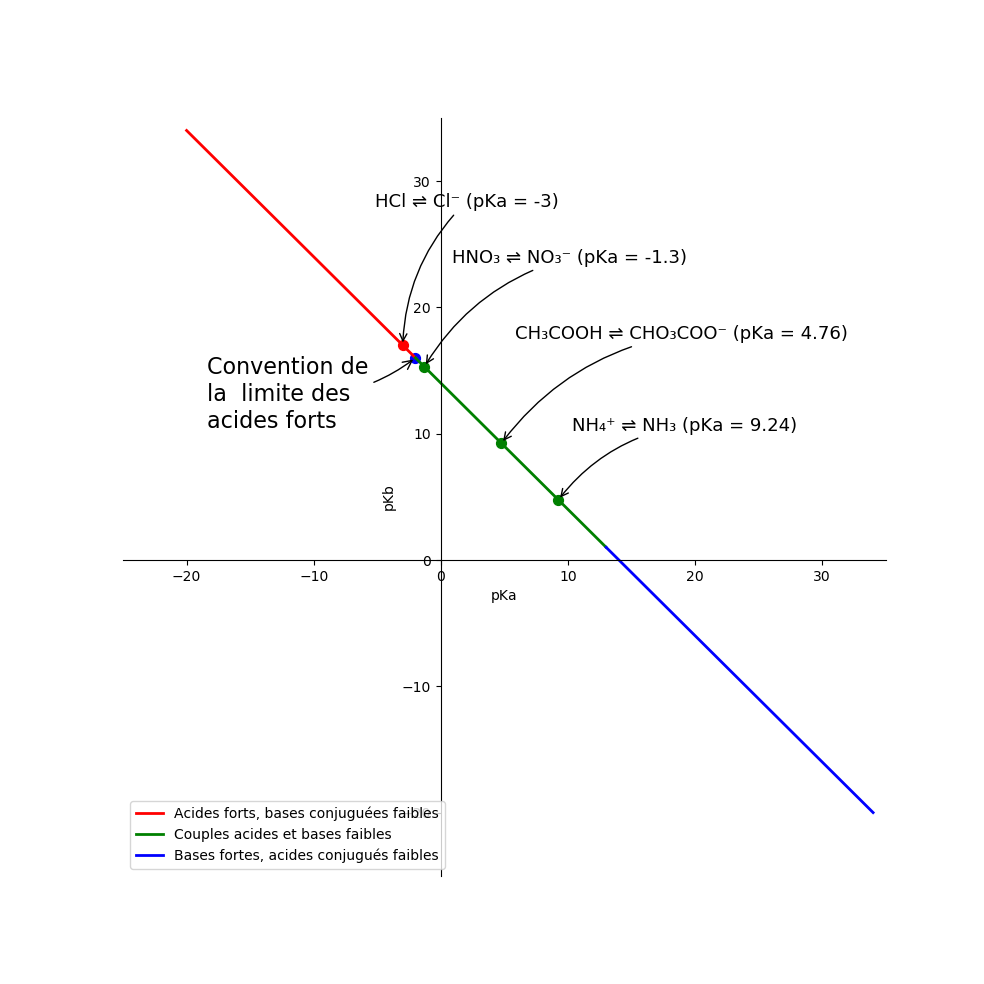Couples acide-base dans le plan pKa/pKb
- Conventions sur les acides forts et les bases fortes : cf. Les acides, les bases et les sels qui nous entourent - Acide fort, base forte
- droite_pKa-pKb-01.py
#!/usr/bin/env python3 # -*- coding: utf-8 -*- """ Library references : * """ import matplotlib.pyplot as plt # directive d'importation standard de Matplotlib import numpy as np # directive d'importation standard de numpy def cm2inch(*tupl): # https://stackoverflow.com/questions/14708695/specify-figure-size-in-centimeter-in-matplotlib inch = 2.54 if isinstance(tupl[0], tuple): return tuple(i/inch for i in tupl[0]) else: return tuple(i/inch for i in tupl) pKasa = np.linspace(-20, -2, 19, endpoint=True) # strong acid pKa = np.linspace(-2, 13, 16, endpoint=True) pKasb = np.linspace(13, 34, 22, endpoint=True) # strong base pKbsa = 14 - pKasa pKb = 14 - pKa pKbsb = 14 - pKasb plt.figure(figsize=cm2inch(25., 25.)) ax1 = plt.subplot(1, 1, 1) plt.plot(pKasa, pKbsa, color="red", linewidth=2.0, linestyle="-", label="Acides forts, bases conjuguées faibles") plt.plot(pKa, pKb, color="green", linewidth=2.0, linestyle="-", label="Couples acides et bases faibles") plt.plot(pKasb, pKbsb, color="blue", linewidth=2.0, linestyle="-", label="Bases fortes, acides conjugués faibles") plt.xlim(-25.0, 35.0) plt.xticks(np.linspace(-20, 30, 6, endpoint=True)) plt.ylim(-25.0, 35.0) plt.yticks(np.linspace(-20, 30, 6, endpoint=True)) plt.xlabel("pKa") plt.ylabel("pKb") plt.legend(loc='lower left') ax = plt.gca() # gca stands for 'get current axis' ax.spines['right'].set_color('none') ax.spines['top'].set_color('none') ax.xaxis.set_ticks_position('bottom') ax.spines['bottom'].set_position(('data',0)) ax.yaxis.set_ticks_position('left') ax.spines['left'].set_position(('data',0)) x = -2 # plt.plot([x, x], [0, 14-x], color='blue', linewidth=2.5, linestyle="--") plt.scatter([x, ], [14-x, ], 50, color='blue') plt.annotate('Convention de\nla limite des\nacides forts', xy=(x, 14-x), xycoords='data', xytext=(-150, -50), textcoords='offset points', fontsize=16, arrowprops=dict(arrowstyle="->", connectionstyle="arc3,rad=.2")) plt.scatter([-3, ],[17, ], 50, color='red') plt.annotate('HCl ⇌ Cl⁻ (pKa = -3)', xy=(-3, 17), xycoords='data', xytext=(-20, +100), textcoords='offset points', fontsize=13, arrowprops=dict(arrowstyle="->", connectionstyle="arc3,rad=.2")) plt.scatter([-1.3, ],[15.3, ], 50, color='green') plt.annotate('HNO₃ ⇌ NO₃⁻ (pKa = -1.3)', xy=(-1.3, 15.3), xycoords='data', xytext=(+20, +75), textcoords='offset points', fontsize=13, arrowprops=dict(arrowstyle="->", connectionstyle="arc3,rad=.2")) plt.scatter([4.76, ],[9.24, ], 50, color='green') plt.annotate('CH₃COOH ⇌ CHO₃COO⁻ (pKa = 4.76)', xy=(4.76, 9.24), xycoords='data', xytext=(+10, +75), textcoords='offset points', fontsize=13, arrowprops=dict(arrowstyle="->", connectionstyle="arc3,rad=.2")) plt.scatter([9.24, ],[4.76, ], 50, color='green') plt.annotate('NH₄⁺ ⇌ NH₃ (pKa = 9.24)', xy=(9.24, 4.76), xycoords='data', xytext=(+10, +50), textcoords='offset points', fontsize=13, arrowprops=dict(arrowstyle="->", connectionstyle="arc3,rad=.2")) plt.savefig("pKa-pKb-plane-01.png") plt.show()
La figure obtenue :
